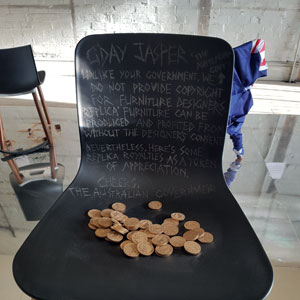Undervalued and Original Fakes
Product Design Melbourne
Ryan Mischkulnig, 31 March 2017
As Melbourne Design week rolls to a close for 2017 we thought we’d bring you a couple of our favourite exhibitions from this year’s event. Both exhibitions responded to important issues within the design world, and both, conveniently, were located at the Piccolina Gelateria in Collingwood.
26 Original Fakes
One of the most common questions asked of us by new clients is how they can best protect their IP (Intellectual Property). Most of the time this question is raised in regards to their proposed product's unique technology or functionality, yet the question can be just as relevant when it comes to the appearance of a product. Melbourne Design Week's 26 Original Fakes exhibition featured 26 artists’ and designers’ opinions on replica furniture, in the form of modified replica HAL chairs as well as written pieces.
1. Alexander Lotersztain - The FAKE
Alexander’s chair represented the problems that can occur when a product is modified or replicated by someone who does not have a good understanding of the original functional intent of a design. The chair was pleasant to look at, but in attaching the seat to the base on the wrong face, the intent of the mounting bosses in the seat have not been understood, hence the poorly modified or replicated product becomes a lesser product to the original.
2. Tomek Archer - Stretch
Visually, we found Tomek Archer’s Stretch to be one of the most visually appealing pieces on display. Instead of looking at the issue from a negative perspective, as most pieces did, Tomek’s chair was closer to an expansion on the original concept. Where most replicas add no value over the original product, and as such can only compete on price, Tomek’s chair actually added value by adding function. By taking the replica HAL chair and substantially increasing its width, 2 children can now sit on it, a function that the original device did not have.
3. Daast - Royalty Paid
Daast used their sense of humour when looking at copyright laws, with their graffiti carved chair and fake $1 coins. In response to the Australian Government’s willingness to allow legal replica furniture to be made, Daast provided some replica royalties for Jasper Morrison (Designer of the HAL chair).
Undervalued
The Undervalued exhibition celebrated the little things. Focussing on products that cost less than $2, €2, or ¥200, the exhibition reminded us that good design adds value to even the smallest, cheapest items. When we celebrate design it is often the large aspirational products that are celebrated; fast cars, high end furniture, intricate houses or digital breakthroughs. We forget the important work that is involved in developing small products, whether it is improving the hearing protection provided by disposable earbuds or making a soy sauce bottle easier to pour.
In Summary
At Bayly we don’t forget about the little things. From innersoles to fencing clips we utilise our Industrial Design and Engineering skills to ensure that our clients and their customers get the best possible product. As designers we understand the costs and time involved in creating exceptional design and we would never promote imitation.
We do, however, understand the value in learning from the work of others, as well as our own experience. Science and Engineering is based around working on the learnings of others, building on their discoveries and challenging them where necessary. Industrial and Product Design is no different, understanding how other products are made and how they function helps us to build even better products for the future.
If you want to build a better product, whether it's huge or insignificant, we would love to hear from you. Contact Bayly on +61 3 9413 9000 or send us an email at This email address is being protected from spambots. You need JavaScript enabled to view it.
Don't miss out. Sign up for our newsletter now!
|

